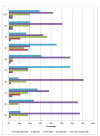Evaluating the Role of Objective Structured Clinical Examination as a Summative Assessment Tool in Undergraduate and Postgraduate Psychiatry Residents
- PMID: 39314613
- PMCID: PMC11417283
- DOI: 10.7759/cureus.67640
Evaluating the Role of Objective Structured Clinical Examination as a Summative Assessment Tool in Undergraduate and Postgraduate Psychiatry Residents
Abstract
Background: The Objective Structured Clinical Examination (OSCE) is the gold standard and universal format to assess medical students' clinical competence in a comprehensive, reliable, and valid manner. OSCE is gaining global popularity for assessing medical students in various specialties. Our country uses it in multiple disciplines, but its application in psychiatry remains limited. OSCE is a resource-demanding assessment method that can face numerous challenges. A comprehensive assessment of perceptions regarding OSCE can help identify areas that need improvement. Therefore, this study was conducted to assess the perceptions of students and examiners toward OSCE in psychiatry.
Aims and objectives: This study aims to evaluate the role of Objective Structured Clinical Examination as a summative assessment tool in assessing competency in undergraduate (as part of their ward leaving examinations in psychiatry) and postgraduate psychiatry residents (as part of their six-monthly assessments) and analyze the perceptions of students as well as of the faculty members regarding OSCE.
Methods: Six MD students and 49 MBBS students took the OSCE as part of their ward-level exams in psychiatry. In the presence of four faculty members of the psychiatry department, students completed their six-month summative exams. The OSCE was held at separate times for UG and PG students. UG and PG students utilized different stations (PG students had a harder level). A 10-item questionnaire was given to examiners and students at the end of the OSCE to get their opinions regarding the OSCE. Furthermore, data gathered from the faculty through an open-ended questionnaire was compiled and displayed thematically. Since the Likert scale survey generated ordinal data, the statistical analysis was conducted using the median, interquartile range (IQR), and chi-square test. The chi-square test was used to compare the variables. A P-value of less than 0.05 was deemed statistically noteworthy.
Results: Four faculty members and fifty-five students in all answered the questionnaire. Regarding the OSCE's characteristics, validity, reliability, and transparency, the majority of students expressed positive opinions. In a similar vein, most examiners had positive perceptions pertaining to OSCE's administration, structure, and procedures. Certain areas, such as "improved confidence in teaching clinical skills" and "improved confidence in giving students structured feedback," were also emphasized by thematic analysis of faculty members.
Conclusion: In general, both students and examiners had extremely favorable perceptions of and embraced the OSCE. Improved faculty orientation and student preparation for the OSCE may help allay anxiety and overcome hesitation related to the exam.
Keywords: assessment; competence; faculty perception; medical education; objective structured clinical examination; psychiatry; reliability; student perception; validity.
Copyright © 2024, Pathak et al.
Conflict of interest statement
Human subjects: Consent was obtained or waived by all participants in this study. HIMS Institutional Ethics Committee (IHEC-HIMSA/FA/RD-05/04-24) issued approval (IHEC-HIMSA/FA/RD-05/04-24). The Institutional Ethics Committee of Hind Institute of Medical Sciences, Sitapur, granted ethical approval for this research on April 12, 2024 (IHEC-HIMSA/FA/RD-05/04-24). Animal subjects: All authors have confirmed that this study did not involve animal subjects or tissue. Conflicts of interest: In compliance with the ICMJE uniform disclosure form, all authors declare the following: Payment/services info: All authors have declared that no financial support was received from any organization for the submitted work. Financial relationships: All authors have declared that they have no financial relationships at present or within the previous three years with any organizations that might have an interest in the submitted work. Other relationships: All authors have declared that there are no other relationships or activities that could appear to have influenced the submitted work.
Figures
Similar articles
-
An evaluative study of objective structured clinical examination (OSCE): students and examiners perspectives.Adv Med Educ Pract. 2019 Jun 5;10:387-397. doi: 10.2147/AMEP.S197275. eCollection 2019. Adv Med Educ Pract. 2019. PMID: 31239801 Free PMC article.
-
Perception of Students and Examiners about Objective Structured Clinical Examination in a Teaching Hospital in Ethiopia.Adv Med Educ Pract. 2021 Dec 11;12:1439-1448. doi: 10.2147/AMEP.S342582. eCollection 2021. Adv Med Educ Pract. 2021. PMID: 34924781 Free PMC article.
-
Experience and Challenges of Objective Structured Clinical Examination (OSCE): Perspective of Students and Examiners in a Clinical Department of Ethiopian University.Ethiop J Health Sci. 2020 May;30(3):417-426. doi: 10.4314/ejhs.v30i3.13. Ethiop J Health Sci. 2020. PMID: 32874085 Free PMC article.
-
Changing an existing OSCE to a teaching tool: the making of a teaching OSCE.Acad Med. 2002 Sep;77(9):932. doi: 10.1097/00001888-200209000-00036. Acad Med. 2002. PMID: 12228103 Review.
-
Objective Structured Clinical Examination (OSCE) in Psychiatry Education: A Review of Its Role in Competency-Based Assessment.Adv Exp Med Biol. 2017;988:159-180. doi: 10.1007/978-3-319-56246-9_13. Adv Exp Med Biol. 2017. PMID: 28971397 Review.
References
-
- Validity and the OSCE. Hodges B. Med Teach. 2003;25:250–254. - PubMed
-
- The assessment of clinical skills/competence/performance. Miller GE. Acad Med. 1990;65:0–7.
-
- Examination of clinical examiners. Wilson GM, Lever R, Harden RM, Roberston JI, MacRitchie J. Lancet. 1969;1:37–40. - PubMed
-
- Dimensionality, internal consistency and interrater reliability of clinical performance ratings. Maxim BR, Dielman TE. Med Educ. 1987;21:130–137. - PubMed
LinkOut - more resources
Full Text Sources

